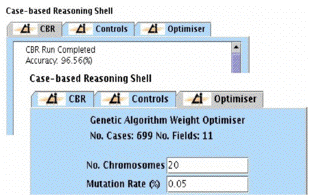Case-based Reasoning - learning through experience
Case-based Reasoning is one of the most successful applied AI
technologies of recent years. Commercial and industrial applications
can be developed rapidly, and existing corporate databases can be used
as knowledge sources. Helpdesks and diagnostic systems are the most
common applications.
Case-based Reasoning
(CBR) is based on the intuition that new problems are often similar to
previously encountered problems and, therefore, that past solutions
may be of use in the current situation. Cases are often derived from
legacy databases, thereby converting existing organisational resources
into exploitable knowledge. CBR is particularly applicable to problems
where the domain is not understood well enough for a robust
statistical model or system of equations to be formulated.
CBR is commonly used for diagnosis (or, more
generally, for classification tasks), e.g., to determine a fault from
observed attributes, or to determine whether or not cancer treatment
is necessary given a set of past cases. AIAI has applied case-based
reasoning to otherwise intractable problems such as fraud
screening.
|
While the case-based reasoning methodology can be applied consistently across
application domains, the implementation of the retrieval and
similarity scoring functions is typically highly customised to the
problem at hand. Two factors become critical: The availability of a
flexible CBR Shell, and the accumulated practical experience of
applying artificial intelligence techniques to real-world
problems. |

|
AIAI, has a
Case-based Reasoning Shell whose design has been developed and refined
over numerous commercial projects. This tool has an advanced
performance optimisation module, based on a genetic algorithm, and
both Java and C++ versions have been implemented.
Fraud Detection
At the request of one of the UK's most
successful fraud detection system software providers, AIAI undertook
an investigation into methods of applying new AI technologies to
increase the accuracy of the already highly advanced systems presently
in use. While the firm's software presently reduces the number of
necessary fraud investigations by several orders of magnitude, our
investigation showed that utilising adaptive algorithms and fuzzy
logic results in significant diagnostic improvement on the most
difficult sub-section of cases. The goal of the work was to reduce the
number of applications referred for costly manual investigation after
the existing detection systems had been utilised. The developed CBR
system was able to prioritise the referred applications from the most
to the least suspicious, aiding the decision process of the fraud
investigator.
|
|

